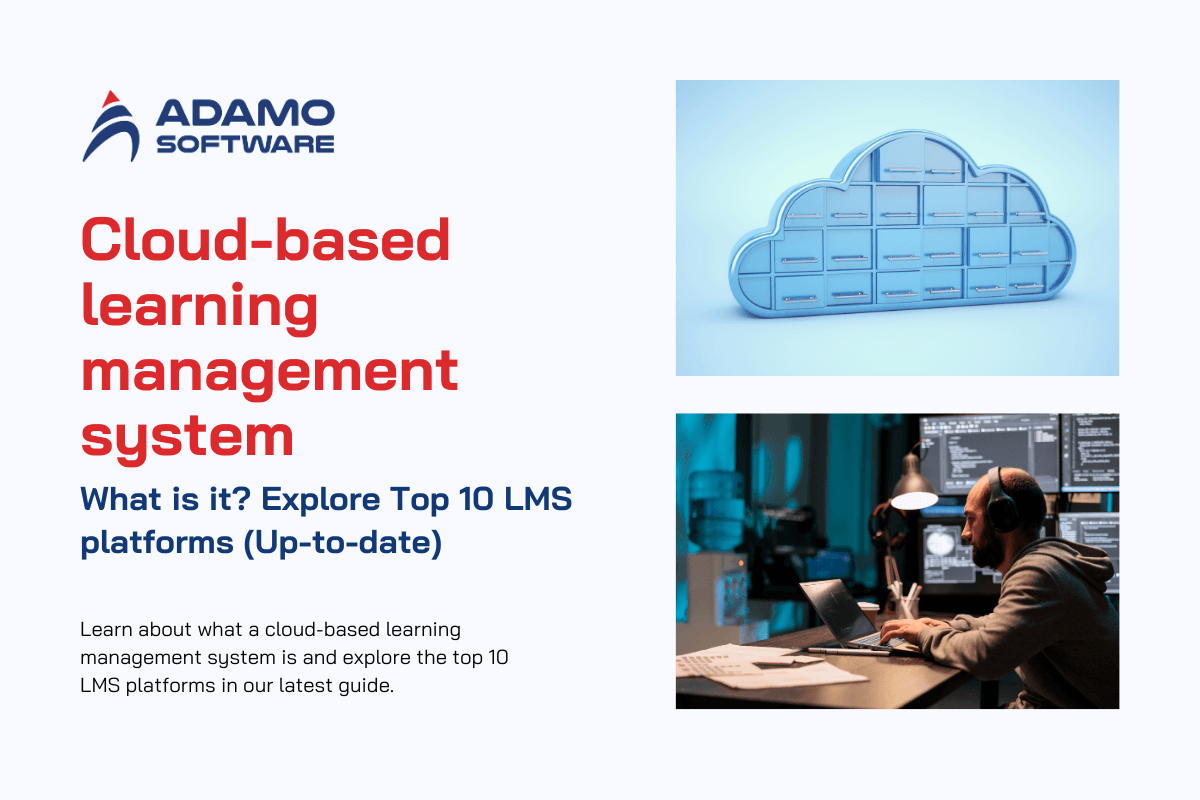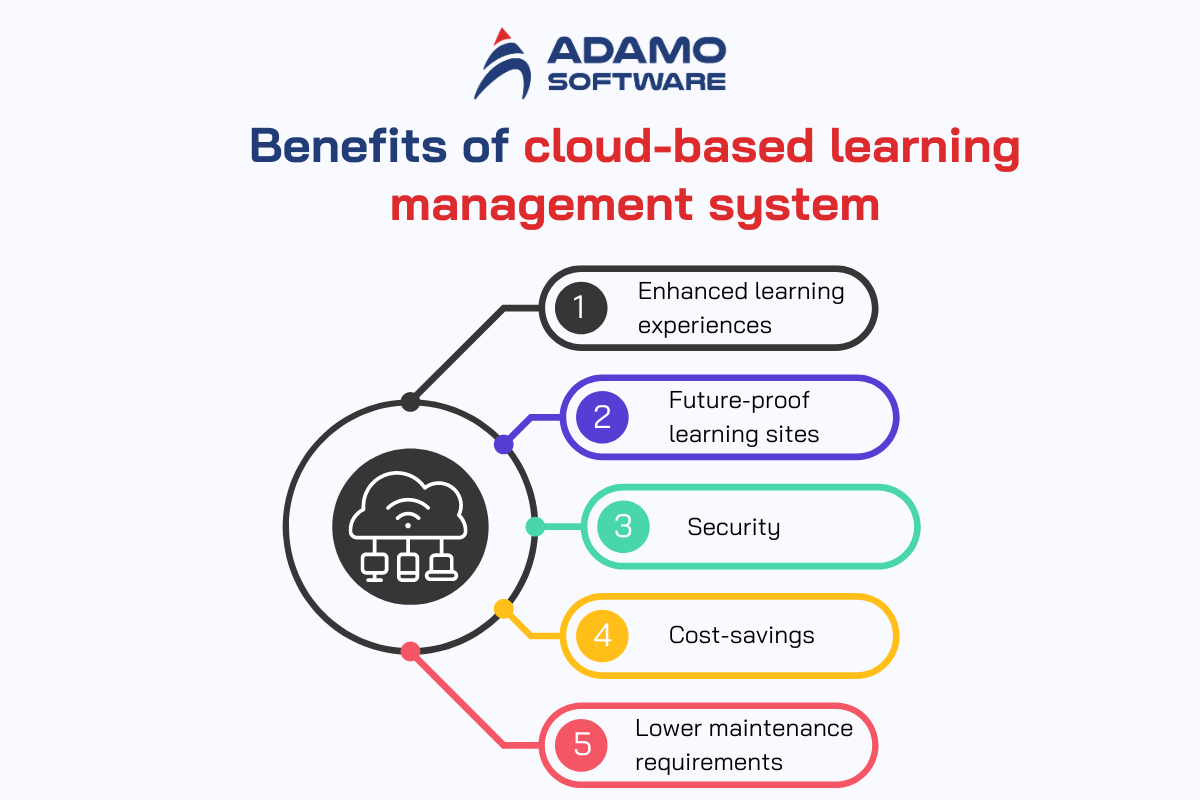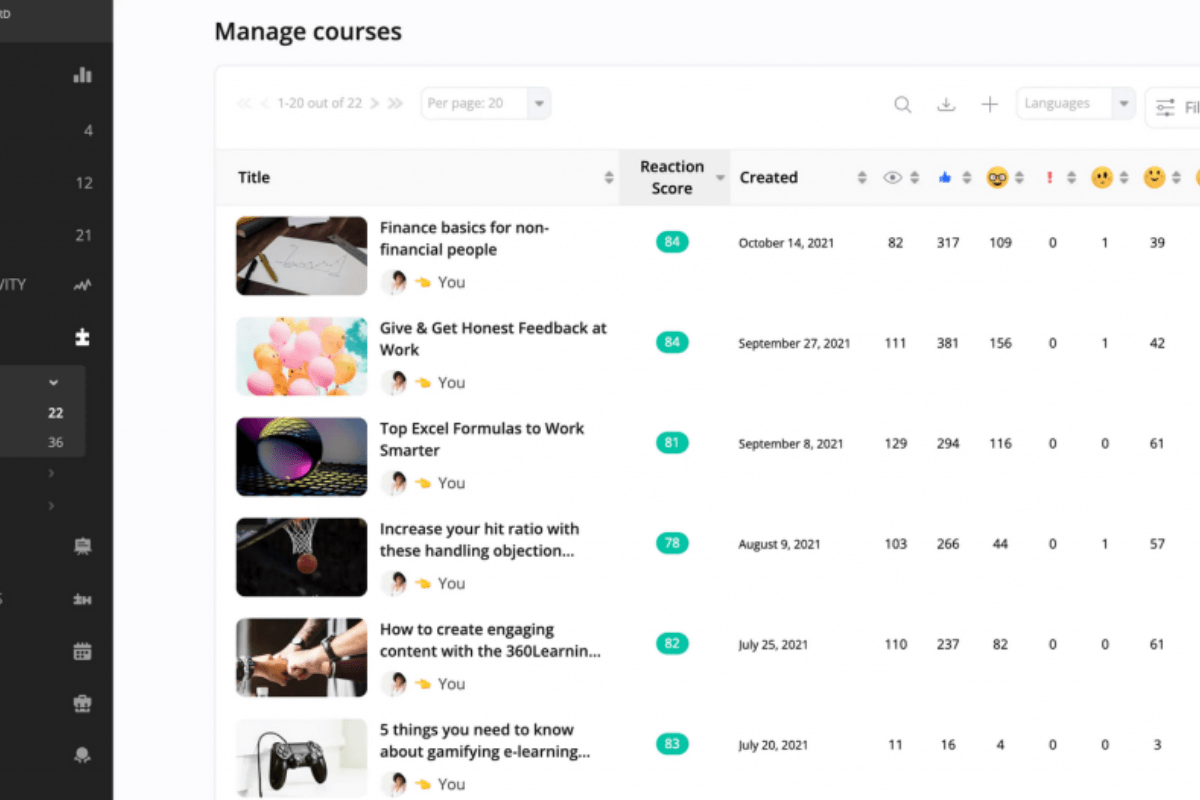What is Cloud-based Learning Management System? Explore Top 10 LMS Platforms [Up-to-date]

The breakout of Covid-19 has made technology solutions for smooth remote work more crucial than ever. Since then, cloud-based systems have become an integral part of many organizations worldwide. Specifically, it was estimated that 94% of companies utilized this type of system in 2023. Indeed, not only does data storage benefit from this, but other activities like learning and development do too.
Education institutions and companies using a cloud-based learning management system can greatly increase the efficiency of their teaching and training activities. If you also want to integrate LMS into your organization but don’t know much about it, read this till the end. This article will introduce you to this trend and look at the up-to-date top 10 LMS platforms in 2024.
I. What is a cloud-based Learning Management System?
You may already know cloud services like Google Drive, which allows you to store data and access it from anywhere via the Internet. A cloud-based learning management system operates based on the same idea. To access your learning materials, you just need to log in from a PC or mobile phone with an internet connection. This allows you to learn from any place, at any time that suits your schedule.
However, LMS has not always been this way. In the early days, LMS solutions appeared as on-premises, or locally hosted. This meant you needed to install an LMS on your local computer through a CD, for example. Though on-premises LMS might offer certain advantages, it also poses a lot of challenges as you will discover in the next section.
The shift to a cloud-based learning management system has brought much more flexibility and accessibility. Therefore, more people can use up-to-date learning materials and personalize their learning progress, hence, increasing learning outcomes.
II. Explore Differences between On-premises and Cloud LMS

1. Accessibility
This one is pretty obvious. On-premises LMS are locally hosted so you can only run them on the PCs where the software has already been installed.
In contrast, a cloud-based learning management system enables users to use it from any device that is connected to the Internet. This feature benefits both learners and course coordinators. Specifically, admins can update course content and learners will see it straight away.
2. Installation
As discussed above, for on-premises LMS to work, you need to install it on your local device and the organization’s local network. This process requires a lot of time and effort to set up.
A cloud-based learning management system, in contrast, can be used directly on the net. In some cases, you may download the software from the vendor’s website and log in with the account provided by your organization.
3. Payments
In many cases, on-premises LMS is a one-time payment. It is a one-off payment whereby you don’t have to pay for subscriptions, renewal, or any other hidden charges.
This is different from a cloud-based learning management system. This might be because cloud-based LMS is more flexible. Naturally, it will be more likely to receive more updates and bug fixes as time goes on. Thus, it is more typical to pay for this sort of software monthly or yearly.
4. Scalability
The on-premises LMS is in your organization’s local network. Hence, you need to ensure that you have enough bandwidth, storage, and computing power as your user base expands.
This can be a problem when your human capital expands. You might find yourself in a situation where you must enroll many new people into your training programs.
In contrast, a cloud-based learning management system enables you to enhance your bandwidth and storage when you need to. Therefore, you can rest assured that a cloud LMS will expand with your organization.
III. Highlight Benefits of Cloud-based Learning Management System

1. Enhanced learning experiences
With a cloud-based learning management system, learners can learn anywhere, at any time, with or without the Internet. This is because many cloud LMS software now allow you to make content available offline.
As users can access their courses on any device whenever they need to, their learning experiences will be significantly improved.
2. Future-proof learning sites
Though we’re not in a pandemic, having a cloud-based learning management system is like preparing yourself in advance for any circumstances. Therefore, when you must transition your learning and development activities to remote, you’ll still be fine.
Not only that, having a cloud-based learning management system is a good way to upskill your employees. Traditional training programs can cost you a lot of time and money. In contrast, a cloud LMS allows you to do this with much less resources and effort. Moreover, your learning materials can be gamified to engage learners and improve learning outcomes as well.
3. Security
It is common knowledge that cloud-based systems are much more secure than traditional IT systems. First of all, traditional or local systems, if malfunctioning or broken down, will make you lose all your data.
However, a cloud-based learning management system can still be accessed even if your local PCs and IT systems stop working. In addition, it can also integrate many security features like encryption or 2FA, which will add extra layers of protection to your data.
4. Cost-savings
In the past, we were used to paying for software all at once. While this can be convenient in a way, it has some downsides too. For instance, to upgrade your on-premises LMS, you might need to purchase new software and install it all over again. It is the same for when you run into hardware issues or are required to upscale the system as your company grows. What this all means is that you will have to pay an unpredictable sum of money for these updates and upgrades of on-premises LMSs.
A cloud-based learning management system, in contrast, follows the per-user pricing model. This means paying a subscription fee for a given time basis depending on the plan that suits your biz at the time. Smaller businesses can choose to pay less for a smaller user base and upgrade their plan later on if necessary. In addition, cloud-based LMSs often come with regular updates and bug fixes, which ultimately helps cut down on costs.
5. Lower maintenance requirements
When using an on-premises LMS, your IT team will be responsible for the software maintenance. However, a cloud-based learning management system will be maintained and regularly updated by its vendor. That’s why it manages to have almost 100% uptime. Hence, cloud LMSs are generally a better choice if you are looking for an economical LMS solution over its lifetime.
IV. Grasp Limitations of Cloud-based Learning Management System

1. No control over the platform
Cloud-based learning management system subscription is pretty much like renting an apartment. You use it every day and pay for it every month, but it is never really yours. This means you can only use what the vendor offers you, and you have little to no control over the platform. Worse, if the vendor goes bankrupt or discontinues the product, your learning materials will also be “homeless” unless you find an alternative.
2. Restrained personalization
Again, because you don’t own the cloud LMS platform, there are only limited things that you can personalize for your specific needs. What a cloud-based learning management system offers you is more of a configuration than a customization. Hence, if you want to make extensive adjustments to the software, then consider going for an on-premises one.
3. Higher spending and pricing increases
As discussed in the previous section, on-premises LMSs might have unpredicted costs but are generally cheaper for companies without scaling plans.
For cloud LMS, as your organization grows, the cost to upgrade and maintain a new subscription plan will be much higher. Therefore, it is crucial to have a clear strategic plan for your organization before deciding which system to use.
4. Security issues
Once your data is online, you’re bound to count cybersecurity as a risk factor. Though a cloud-based learning management system must adhere to very strict security standards, nothing can be guaranteed. Because of this risk, some may opt for on-premises solutions for greater control over their data.
However, newer security options for cloud-based services often can offer way more security than most organizations can internally. Therefore, the benefits of using cloud LMSs are generally greater than their limitations.
V. Features of Cloud Learning Management System
Some of the must-have features for a cloud-based learning management system include:
- Reduced Downtime: Cloud LMSs are more stable, and therefore, cut down on downtime. This will ensure you have consistent access to your software.
- Easy Disaster Recovery: Cloud LMSs can be easier to maintain and have integrated data backups that will save you from data loss struggles.
- Improved Integration Ability with Other Services: One of the coolest features of a cloud-based LMS is integration with other platforms. Thanks to this, you can enhance the learning experience of users.
VI. Understand Top 10 Cloud-based Learning Management System (Cloud LMS)
1. TalentLMS
TalentLMS is a cloud-based learning management system for online learning and training activities. It is suitable for companies across various sectors. One of TalentLMS’s priorities is making it easy to use for users, so don’t worry about long setup procedures. The platform also has engaging features such as gamification to enhance the learning experience.
Top features:
- Integrated content creation tool
- Monitoring of learner progress
- Reporting and analytics
2. Absorb LMS
Absorb LMS is a cloud LMS ideal for those who want to emphasize mobile learning and analytics. This cloud-based learning management system has a feature called Smart Administration, which enables administrators to automate routine work. It also helps you see the big picture of your learning stats visualized in a dashboard. AI-powered options are also available to help you increase your team’s efficiency.
Absorb LMS also works for all types of companies. Its integrated e-commerce feature will benefit those who want to monetize their learning materials.
Top Features
- Adjustable cloud-based LMS
- AI capabilities and automation
- Comprehensive e-commerce integration
3. Docebo
Next up on the list of cloud-based learning management systems for 2024 is Docebo. This is a cloud LMS that will help you effectively manage all of your learning and training materials of all kinds. Docebo also has built-in AI features that help break down content into smaller lessons for ease of learning. Additionally, it can be integrated into widely used tools like Lectora or Elucidat.
This cloud-based learning management system will be a great choice for both corporates and NPOs in training and hosting webinars.
Top Features
- AI-powered virtual tutor and personalized learning content suggestions
- Social learning and gamification to boost learner engagement
- Integration with more than 400 productivity and enterprise apps
- Mobile learning accessible on any internet-connected device
4. Litmos
Another easy-to-use cloud LMS that you can consider is Litmos. This cloud-based learning management system has an integrated content marketplace feature, giving you a wide range of courses to choose from. Limos is most suitable for companies that need an all-in-one kind of solution. That’s because you can have ready-made materials once you purchase the software, which saves you plenty of time on content planning and publishing.
Top Features
- Centralized management of learning and development
- Customized content
- Instructor-led training module for virtual classrooms
5. LearnUpon
LearnUpon is the next cloud LMS we’ll include in this list. Similar to many other cloud-based learning management systems, it is very easy to set up. One of LearnUpon’s focus areas is making the learning management process more optimized. Therefore, all the related tasks are gathered in one central place for ease of access.
LearnUpon is the ideal pick for companies that are new to training management systems. That’s because they have a team of experts in building customer experience to help you out.
Top Features
- Customizable learning environments with Portals
- Webinar platform integrations for blended learning
- Automated user creation and enrollment
6. 360Learning
For those looking for a new and different solution, 360Learning might be exactly what you need. 360Learning team believes that a trainer can be anyone. Therefore, they built this platform to help you become an expert in learning and development. This means each employee can pilot their own growth and skill enhancement process without being dependent on an instructor.

This platform is perfect for companies that want to prioritize collaboration. However, it might not be the right choice for those who want to go for a formal training procedure.
Top Features
- Emphasis on collaborative learning
- AI-driven learning path recommendations
- Salesforce integration
7. MoodleCloud
Having limited financial resources? Moodle brings great news here: it is popular, highly customizable, and most importantly, FREE. However, this version can be difficult to deal with during installation and maintenance, especially for those without much technical knowledge.
That’s why MoodleCloud came along. It is a cloud-based alternative to Moodle, which is much simpler to use and has proven effective. Moodle Cloud also has a relatively cheap starting price for a subscription, at only about over $100 for 50 users.
Top features
- Diverse formats for learning content and tasks
- Social learning features
- Learner progress tracking and analysis
8. iSpring Learn LMS
iSpring Learn is an LMS created for businesses to coordinate different forms of learning activities. It is equipped with content creation tools, an important feature for organizations without learning content initially. The platform is designed to permit multiple admin roles so that team leaders and department heads can deal with the training administration. It is especially ideal for any organization searching for a comprehensive training solution.
When used with iSpring Suite, it provides everything from developing the course to measuring e-learning ROI. In particular, one of the main advantages of the iSpring Suite is the capacity to turn PowerPoint files into SCORM files. This will be valuable for organizations that do not employ an L&D department.
Top features
- Create learning content using PowerPoint
- Unlimited cloud storage
- Gamification with points and badges
9. LearnWorlds
LearnWorlds is a Software as a Service LMS that is characterized by the emphasis on e-commerce within the platform. Hence, it provides users with the tools for creating courses that can then be sold online. It is endowed with powerful features for those schools and organizations who would like to make money based on their experience and products.
The software enables fully personalized and company-branded web presences and mobile apps using numerous whitelabeling features. In the same way, LearnWorlds supports marketing & affiliate tools to help in the promotion and selling procedures. This makes it an ideal solution for online schools, universities, companies, and influencers who want to sell courses effectively online.
Top features
- Integrated marketing and sales tools
- White-labeled website and mobile app builder
- SCORM-compliant
10. Canvas
Canvas is an open-source LMS providing a platform in cloud infrastructure developed mainly for educational institutions. It has several functionalities that assist the instructors in developing, administering, and disseminating learning material. As part of the K-12 tools, Canvas is created by Instructure and is supported by Mastery for formative assessments and elevate for analytics.

Although it is specially developed for k12, higher education, and other organizations, the use of Canvas is also possible in the corporate environment. It enables the monitoring and assessment of the learners’ progress and the evaluation of the course’s effectiveness.
Top features
- Live audio and video chat
- Unlimited file size
- Third-party integrations with tools like Nearpod and Google Assignments
Also read: How to Design LMS to Boost User Experiences? Best Practices for Business Owners
VII. What Makes Adamo Suitable for Developing Cloud-based Learning Management Systems?
Consider working with Adamo Software for a cloud-based LMS, as we offer the best software development solutions for building secure, scalable, and easy-to-use LMS.

Adamo has experience in cloud technologies and web-based platforms. Hence, we can help you design scalable LMS platforms that enable remote learning and instant access to data. Our team put a strong emphasis on usability to make the system easy for educators and learners.
Additionally, Adamo offers such enhanced tools as Artificial Intelligence, Content Management, and Mobile Responsiveness to provide flexibility and interactivity in learning.
Contact us now to get started on your cloud LMS solution.





